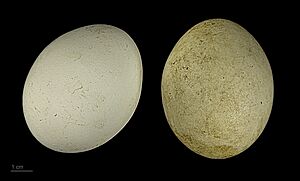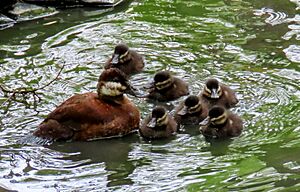Ruddy duck facts for kids
Quick facts for kids Ruddy duck |
|
|---|---|
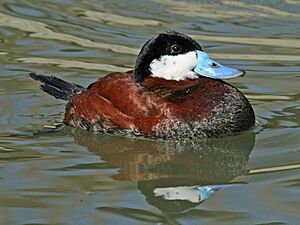 |
|
| Male | |
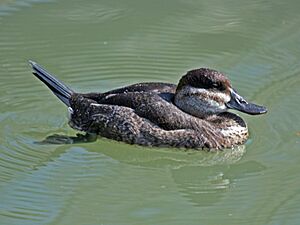 |
|
| Female | |
| Conservation status | |
| Scientific classification | |
| Genus: |
Oxyura
|
| Species: |
jamaicensis
|
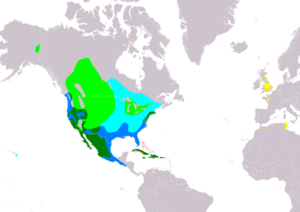 |
|
| Extant, breeding Extant, resident Extant, passage Extant, non-breeding Extant & Introduced (resident) Probably extinct | |
| Synonyms | |
|
Erismatura jamaicensis |
|
The ruddy duck (Oxyura jamaicensis) is a type of duck that comes from North America. It is known for its stiff tail, which it often holds pointing upwards. The name Oxyura means "sharp tail" in Ancient Greek. The word jamaicensis means "from Jamaica", which is where this duck was first found.
Contents
How Scientists Name Them
Scientists have a special way to name and group all living things. This is called taxonomy. The ruddy duck was first officially described in 1789. This was done by a German scientist named Johann Friedrich Gmelin. He put it in the same group as other ducks and swans.
Later, in 1828, another scientist named Charles Lucien Bonaparte created a new group just for ducks like the ruddy duck. This group is called Oxyura. The name Oxyura comes from two old Greek words. Oxus means "sharp," and oura means "tail." So, it means "sharp tail," which fits this duck well! The second part of its scientific name, jamaicensis, tells us it was first found in Jamaica.
What Do Ruddy Ducks Look Like?
Ruddy ducks are small and round. They have strong, scoop-shaped bills. Their long, stiff tails often stick up in the air. Their heads are slightly pointed, and their necks are short and thick.
- Males in Summer: Male ruddy ducks have black caps on their heads. These stand out against their bright white cheeks. Their bodies are a rich reddish-brown color. They also have bright blue bills.
- Males in Winter: In winter, the males look different. Their bodies are dull gray-brown on top and lighter underneath. Their bills are a dull gray.
- Females and Young Males: Females and young males look similar to winter males. They are mostly brownish. They have a lighter patch on their cheek, but it has a blurry stripe across it.
- In Flight: When ruddy ducks fly, the tops of their wings look completely dark.
| Standard Measurements | |
|---|---|
| Total Body Length | 340–430 mm (13.5–17 in) |
| Weight | 560 g (1.23 lb) |
| Wingspan | 470 mm (18.5 in) |
| Wing Length | 133–147.5 mm (5.24–5.81 in) |
| Tail Length | 67–79 mm (2.6–3.1 in) |
| Bill Length | 38.5–41 mm (1.52–1.61 in) |
| Leg Length | 33–38 mm (1.3–1.5 in) |
Reproduction and Habits
Ruddy ducks like to breed in lakes and ponds that have lots of marshy plants. They build their nests in thick plants close to the water. The female duck builds the nest using grass. She hides it well in tall plants to keep it safe from animals that might try to eat the eggs. A female ruddy duck usually lays 5 to 15 eggs. Each year, new pairs of ducks form to breed.
These ducks are migratory. This means they travel to different places depending on the season. In winter, they fly to coastal bays and lakes that do not freeze.
Ruddy ducks are excellent divers and swimmers underwater. They mostly eat seeds and roots from water plants. They also enjoy eating water insects and small crustaceans like tiny crabs.
Ruddy Ducks as an Invasive Species
Sometimes, animals are brought to new places by people. If they spread quickly and cause problems for the local wildlife, they are called an invasive species.
In the late 1950s, some ruddy ducks escaped from bird collections in Great Britain. They started to live and breed there. From Britain, they spread to other parts of Europe. This caused a problem because ruddy ducks are very aggressive when they are looking for a mate. They would try to breed with the native white-headed duck (Oxyura leucocephala), which is an endangered species in southern Europe. This mixing of species was a big worry for conservationists in Spain.
Because of this, some countries in Europe started programs to manage the ruddy duck population. The goal was to reduce their numbers in places where they were not native. This was done to protect the endangered white-headed duck.
Since 2016, the ruddy duck has been on a special list in Europe called the "Invasive Alien Species of Union concern." This means that in the whole European Union, people are not allowed to import, breed, transport, sell, or intentionally release ruddy ducks into the environment. This rule helps protect the native wildlife from the problems caused by invasive species.



